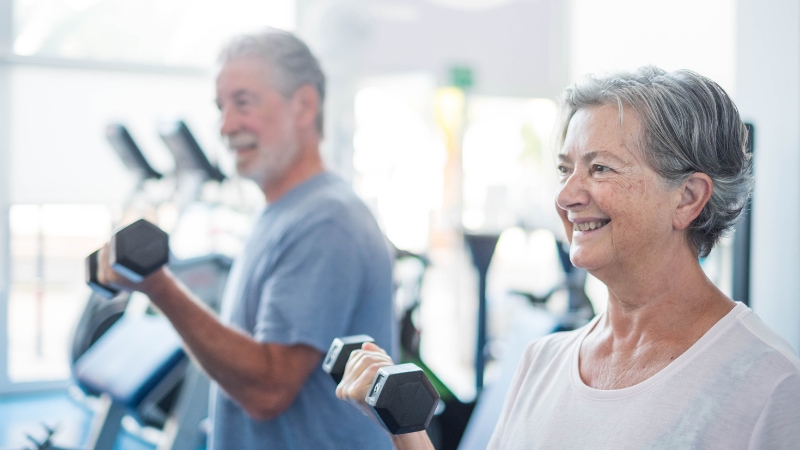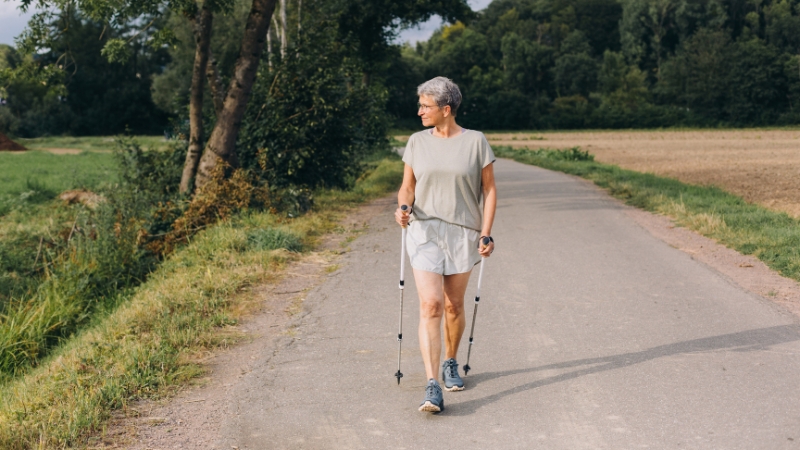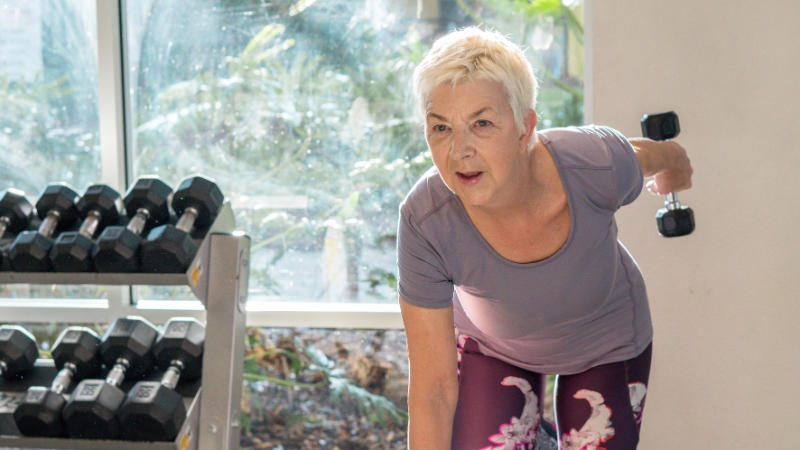
Share Post:
Aging comes with plenty of surprises—some sweet, like finally having time for hobbies or grandkids, and others… not so sweet. One of the biggest challenges? Gradual loss of strength.
We’re talking about a quiet, steady decline in muscle mass that sneaks up starting in the 30s and ramps up after 60.
It’s called sarcopenia, and unless something is done about it, it can lead to trouble—trouble with stairs, carrying groceries, or even standing up from a chair.
But here’s the good news: there’s a highly effective, science-backed way to fight back—and it doesn’t require a gym membership, a personal trainer, or a background in fitness. It’s called strength training, and for seniors over 65, it can quite literally be life-changing.
Let’s take a closer look at why it matters so much, what it actually does for the body, and how to get started safely.
Table of Contents
ToggleWhat Happens to Muscle as We Age?
You don’t need to be a scientist to notice that our bodies change with age. But behind the scenes, something very specific is happening: starting around age 35, we lose about 1–2% of muscle mass each year.
That loss speeds up to 3% per year after 60, according to research from the National Center for Biotechnology Information (NCBI). And by the time someone reaches their 70s or 80s, they may have lost between 15–30% of their original strength.
That drop isn’t just about looking less toned. It’s about mobility, balance, and independence. Less muscle means more fatigue, a higher risk of falls, and greater difficulty doing basic things like cooking, climbing stairs, or getting dressed.
Why Strength Training Works—Especially After 65

Strength training (also called resistance training) means using some kind of resistance—dumbbells, resistance bands, your own body weight—to challenge your muscles. And challenge is the key word here, because when muscles are pushed (safely), they respond by growing stronger.
Let’s go deeper into the biggest ways strength training helps older adults stay healthy, independent, and resilient.
1. Reverses or Slows Sarcopenia
Sarcopenia may be common, but it’s not inevitable. Studies show that strength training—even for beginners in their 60s, 70s, or beyond—can increase muscle mass by up to 10% in just 6 to 9 weeks, especially when training is done at a moderate intensity (60–85% of your max effort).
Let’s say someone in their late 60s begins doing chair squats and light resistance band work three times a week. That alone can start to rebuild lost muscle, making everyday tasks feel easier and helping them avoid the cascade of physical decline that often comes with aging.
2. Improves Mobility and Everyday Function
You know that feeling when your legs just don’t want to get up from the couch? Weak quads and glutes are usually to blame. That’s why exercises like squats and sit-to-stand reps are so effective for seniors—they target exactly the muscles that help us move around confidently.
Research from the NCBI shows that training just 2–3 times a week for 20–30 minutes can significantly improve how far someone can walk, how well they balance, and how quickly they can move.
Even something as basic as getting up from the floor becomes less daunting when your legs, hips, and core are stronger.
3. Reduces the Risk of Falls—Big Time
Strength and balance exercises are beneficial in reducing falls risk. Exercises should be tailored to the individual but here is a short video from @thecsp to support older adults to stay active at home#FallsAwarenessWeek https://t.co/CQ7rC5wimc
— AGILE (@AGILECSP) September 24, 2021
Falls are a serious concern for seniors. One in three adults over 65 falls each year, and the consequences can be devastating—broken hips, hospitalizations, and a steep decline in quality of life.
According to Harvard Health and NCBI, regular strength training—especially when paired with balance work—can cut fall risk by up to 30%.
Think of exercises like:
- Standing on one leg for 10–15 seconds
- Heel-to-toe walking
- Gentle lunges while holding onto a chair
Even light effort in these areas creates big wins in stability and confidence.
4. Helps Manage or Prevent Chronic Conditions
Strength training isn’t just for the muscles you can see. It has powerful effects inside the body too:
- Heart health: Lifting weights improves circulation, lowers blood pressure, and helps the heart work more efficiently.
- Diabetes: Strength training increases insulin sensitivity, helping with blood sugar control.
- Arthritis: Gentle resistance work reduces joint pain and improves flexibility, especially important for hips, knees, and hands.
- Osteoporosis: Exercises that load the bones (think weighted squats or even walking with light dumbbells) help maintain bone density and reduce fracture risk.
The takeaway? Resistance training is a full-body prescription for better health.
5. Supports Independence and Daily Living

Let’s say someone’s in their early 70s and has started to avoid certain errands because lifting things or standing for too long has become exhausting. That’s a red flag—not of laziness, but of strength slipping away.
Now, imagine that same person after 10–12 weeks of structured strength training. Tasks like:
- Carrying a laundry basket
- Gardening
- Climbing stairs
- Holding a squirmy grandchild
…all become doable again.
Independence isn’t about doing everything alone—it’s about having the physical ability to choose what you want to do without fear of falling or getting hurt.
For those in Phoenix seeking environments that support both independence and specialized memory support, memory care in Phoenix communities offers comprehensive solutions.
6. Boosts Mental Health and Cognitive Function
The mental health benefits of strength training are often overlooked, but they’re huge:
- Mood improvement: Lifting weights or even doing simple resistance band work releases endorphins, reducing stress and boosting mood.
- Cognitive function: Regular strength training can slow age-related cognitive decline and may even improve executive function and memory.
- Confidence: Feeling stronger leads to feeling more in control of your body, and that matters at any age.
What Does Strength Training Look Like for Seniors?
The best part? It doesn’t have to be complicated. Here’s a breakdown of practical options:
| Exercise Type | Examples | Equipment Needed |
| Bodyweight | Chair squats, wall push-ups, toe raises | None |
| Resistance Bands | Bicep curls, shoulder presses, seated rows | Resistance bands |
| Light Weights | Dumbbell rows, overhead presses, leg extensions | Dumbbells (1–5 kg) |
| Daily Activities | Carrying bags, vacuuming with purpose, stair climbing | None |
Mix and match 5–6 exercises into a short session, 2–3 times a week. That’s all it takes to see changes.
How to Train Safely and Effectively
View this post on InstagramA post shared by Mitch | 71 y/o Senior Fitness Trainer (@foreverfitwithmitch)
Seniors don’t need high-intensity gym sessions to build strength. They just need consistency and the right approach:
- Frequency: 2–3 sessions per week
- Duration: 20–30 minutes per session
- Progression: Increase reps, sets, or resistance every 6–8 weeks
- Intensity: Moderate effort is enough; the goal is “challenging but doable”
- Include balance: Add tai chi, yoga, or single-leg exercises
- Stretching: Always warm up and cool down gently
And above all: listen to the body. Some soreness is normal, sharp pain isn’t.
Common Worries—and How to Work Around Them
“I’ve never lifted weights before.”
That’s completely okay. Most seniors start with bodyweight movements and progress gradually. No prior experience needed.
“I have arthritis or chronic pain.”
Strength training can actually reduce joint pain over time. Start with light resistance and consult a professional if needed.
“I don’t want to join a gym.”
No problem. A chair, a resistance band, and a bit of space at home is more than enough.
“I’m afraid of hurting myself.”
That fear is valid—but manageable. With proper form and a slow pace, strength training is one of the safest types of exercise for older adults.
Getting Started the Right Way

Before jumping into a new routine, it’s wise for older adults to speak with their healthcare provider, especially if they’re managing chronic conditions. A physical therapist or certified trainer with experience in senior fitness can help design a safe, personalized plan.
Final Thoughts
Strength training isn’t about bulking up. It’s about being able to lift your suitcase, keep up with your grandkids, or carry groceries without fear. It’s about being steady on your feet and confident in your body.
For adults over 65, a little bit of resistance work goes a long way. In just two to three sessions a week, seniors can slow muscle loss, improve balance, reduce fall risk, manage chronic conditions, and boost mental health.
So whether it’s a set of dumbbells, a resistance band, or just your own body weight, grab it. It’s never too late to get strong.
Related Posts:
- 8 Fitness Certifications For Training Beginners,…
- Why Teeth Grinding Is Common Among People Who Do…
- Simple Training Tips for Adults Over 50 Who Want to…
- Cardio vs. Strength Training for Aging Bodies -…
- Strength Training for Women - Busting the Bulky Muscle Myth
- What Happens to Blood Sugar During Strength Training…













